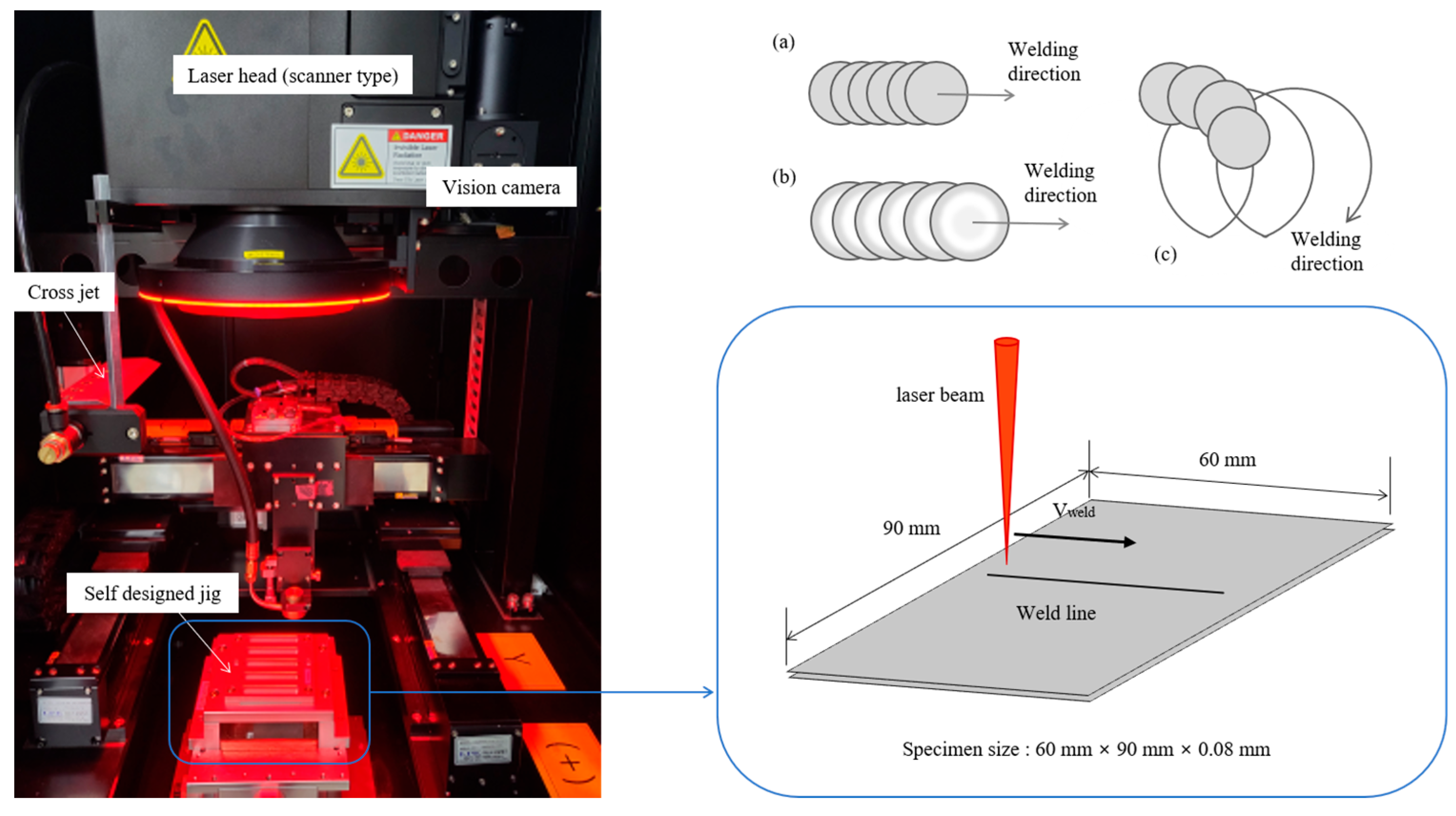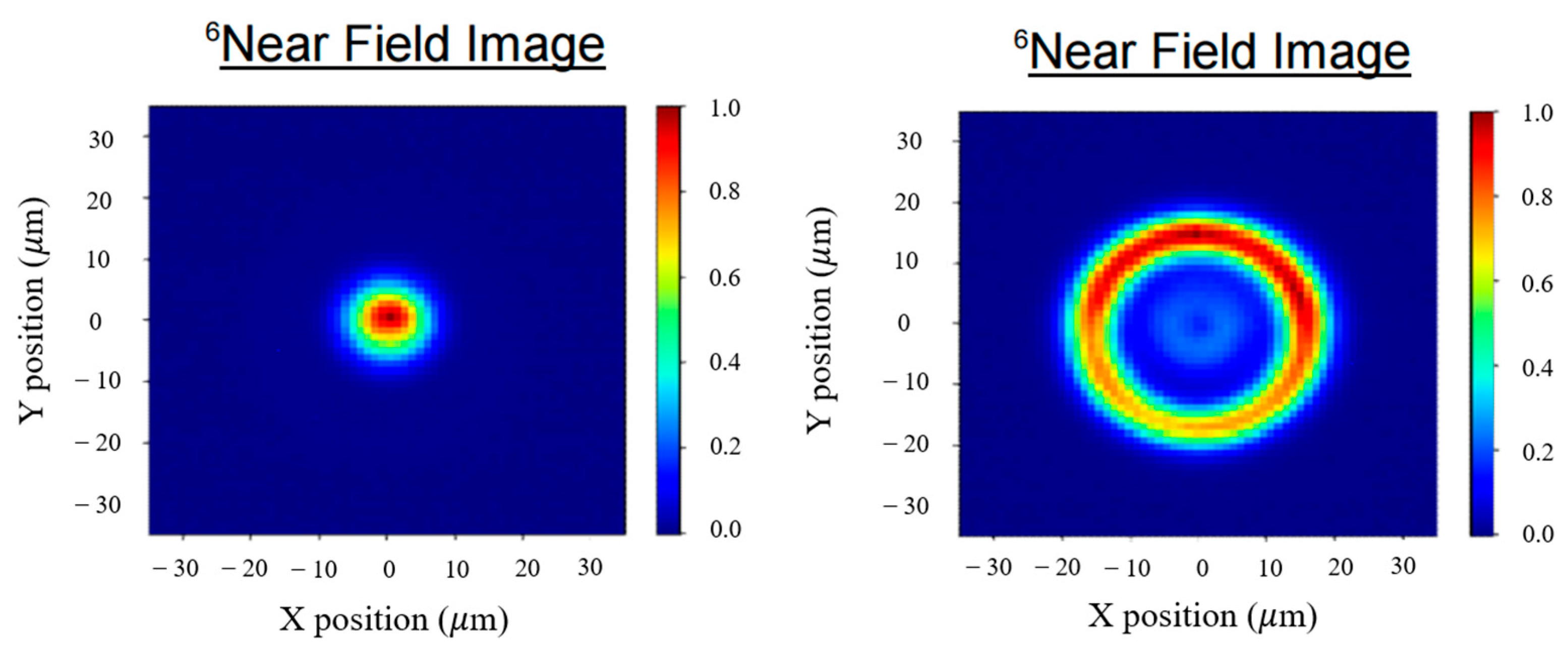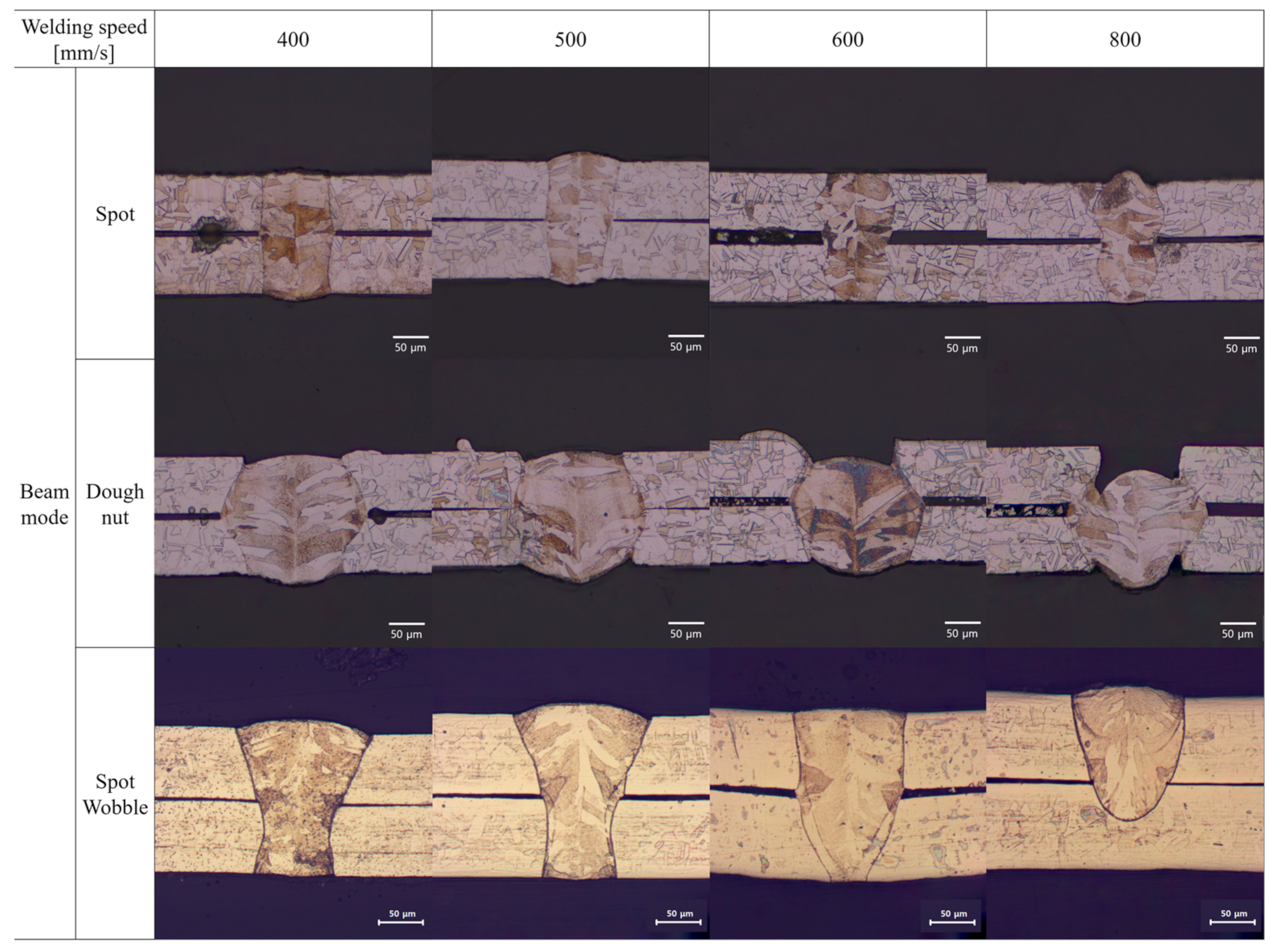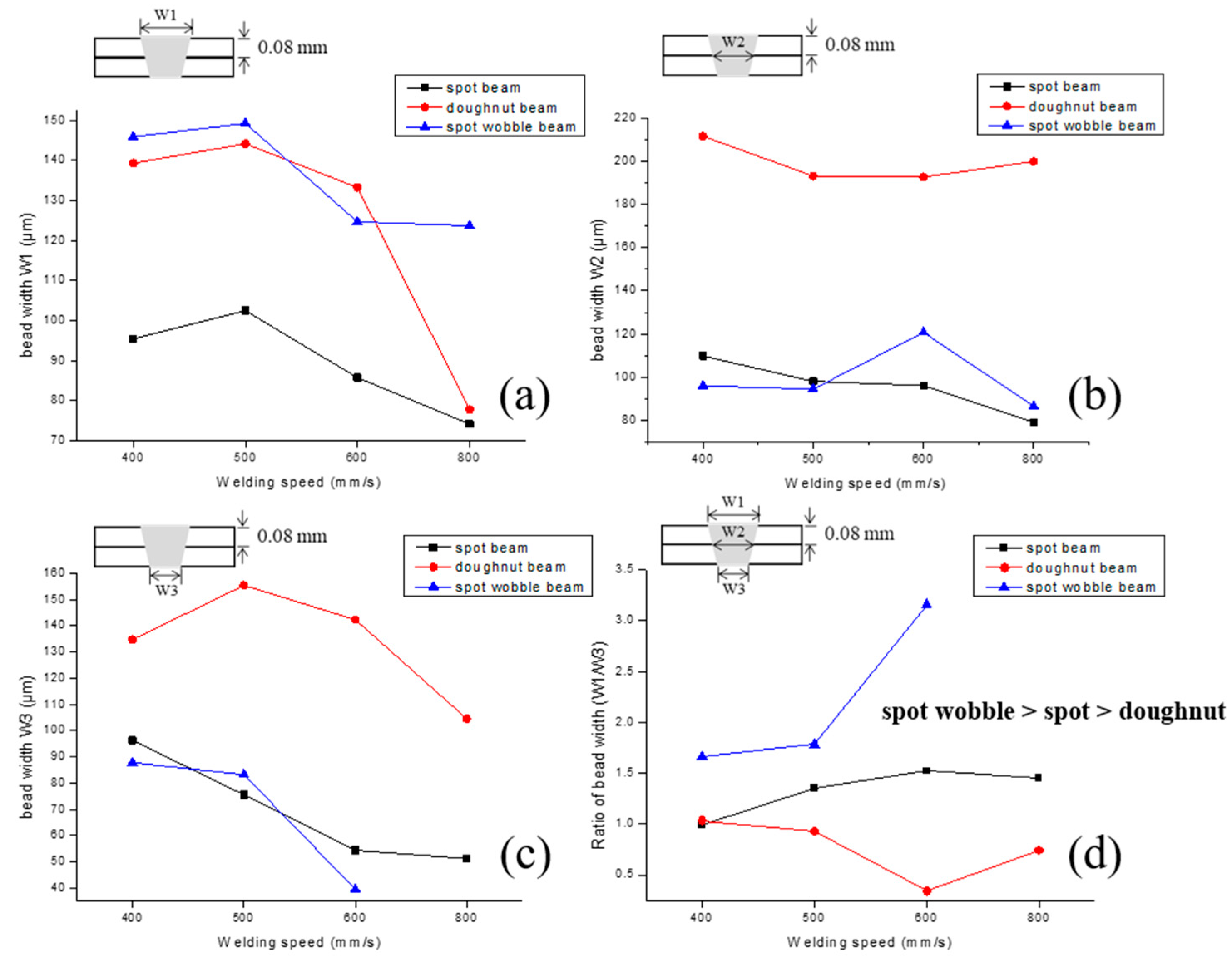Effects of Beam Shape on the Microstructures and Mechanical Properties during Thin-Foil Laser Welding
Abstract
1. Introduction
2. Materials and Methods
3. Results and Discussion
3.1. Surface and Cross-Sectional Morphology of the Welded Area
3.2. Mechanical Charateristics of the Welded Area
3.3. Microstructrue Characteristics of the Welded Area
4. Conclusions
- The thin 316 L stainless steel plate is very difficult to weld because of its welding deformation and loss of molten metal. For ultra-high-speed laser welding of thin plates, a high-power laser could be used to reduce the heat-affected zone and the molten pool. From this, a superior laser welding condition for thin plate was deduced in this study. The optimal welding speed was 500 mm/s.
- If the welding speed was too high, some defects, such as undercuts, were generated because the molten pool did not have enough time to spread and incomplete penetration occurred at a rapid cooling rate. In spot and doughnut beam welding, defects, such as humping beads, were observed as the welding speed increased, whereas the spot-wobble beam had relatively minor surface defects.
- As a result of the microstructure investigation, the doughnut-beam-welded joint had the largest average grain size among the experimental conditions. This is due to the slow cooling rate, which causes high heat input despite its low energy density.
- When the ratio of the bead top width to the bead bottom width was compared, the spot beam had a ratio close to 1, suggesting the penetration of the overall weld cross-section was straight. The spot-wobble beam had the sharpest penetration shape, and the doughnut beam had a circular weld cross-section. The spot-wobble beam could achieve the highest tensile strength and was the optimal beam shape for stainless steel sheet welding.
- As the heat input increased during welding, the fractions of HAGB and CSL decreased. Moreover, the proportion of LAGB increased with a longer cooling time.
Author Contributions
Funding
Data Availability Statement
Acknowledgments
Conflicts of Interest
References
- Das, A.; Fritz, R.; Finuf, M.; Masters, I. Blue laser welding of multi-layered AISI 316L stainless steel micro-foils. Opt. Laser Technol. 2020, 132, 106498. [Google Scholar] [CrossRef]
- Wang, Y.; Chen, K.S.; Mishler, J.; Cho, S.C.; Adroher, X.C. A review of polymer electrolyte membrane fuel cells: Technology, applications, and needs on fundamental research. Appl. Energy 2011, 88, 981–1007. [Google Scholar] [CrossRef]
- Tu, Z.; Zhang, H.; Luo, Z.; Liu, J.; Wan, Z.; Pan, M. Evaluation of 5 kW proton exchange membrane fuel cell stack operated at 95 °C under ambient pressure. J. Power Sources 2013, 222, 277–281. [Google Scholar] [CrossRef]
- Dubal, D.P.; Ayyad, O.; Ruiz, V.; Gómez-Romero, P. Hybrid energy storage: The merging of battery and supercapacitor chemistries. Chem. Soc. Rev. 2015, 44, 1777–1790. [Google Scholar] [CrossRef] [PubMed]
- Wang, Y.; Northwood, D.O. An investigation into TiN-coated 316L stainless steel as a bipolar plate material for PEM fuel cells. J. Power Sources 2007, 165, 293–298. [Google Scholar] [CrossRef]
- Cho, K.; Lee, W.; Lee, S.; Jang, H. Corrosion resistance of chromized 316L stainless steel for PEMFC bipolar plates. J. Power Sources 2008, 178, 671–676. [Google Scholar] [CrossRef]
- Zhao, Y.; Wei, L.; Yi, P.; Peng, L. Influence of Cr-C film composition on electrical and corrosion properties of 316L stainless steel as bipolar plates for PEMFCs. Int. J. Hydrogen Energy 2016, 41, 1142–1150. [Google Scholar] [CrossRef]
- Larijani, M.; Yari, M.; Afshar, A.; Jafarian, M.; Eshghabadi, M. A comparison of carbon coated and uncoated 316L stainless steel for using as bipolar plates in PEMFCs. J. Alloys Compd. 2011, 509, 7400–7404. [Google Scholar] [CrossRef]
- Jin, J.; Zhang, J.; Hu, M.; Li, X. Investigation of high potential corrosion protection with titanium carbonitride coating on 316L stainless steel bipolar plates. Corros. Sci. 2021, 191, 109757. [Google Scholar] [CrossRef]
- Pakmanesh, M.; Shamanian, M. Optimization of pulsed laser welding process parameters in order to attain minimum underfill and undercut defects in thin 316L stainless steel foils. Opt. Laser Technol. 2018, 99, 30–38. [Google Scholar] [CrossRef]
- Kim, J.; Kim, S.; Kim, K.; Jung, W.; Youn, D.; Lee, J.; Ki, H. Effect of beam size in laser welding of ultra-thin stainless steel foils. J. Mater. Process. Technol. 2016, 233, 125–134. [Google Scholar] [CrossRef]
- P’ng, D.; Molian, P. Q-switch Nd:YAG laser welding of AISI 304 stainless steel foils. Mater. Sci. Eng. A 2008, 486, 680–685. [Google Scholar] [CrossRef]
- Ventrella, V.A.; Berretta, J.R.; de Rossi, W. Pulsed Nd:YAG laser seam welding of AISI 316L stainless steel thin foils. J. Mater. Process. Technol. 2010, 210, 1838–1843. [Google Scholar] [CrossRef]
- Tan, W.; Shin, Y.C. Laser keyhole welding of stainless steel thin plate stack for applications in fuel cell manufacturing. Sci. Technol. Weld. Join. 2015, 20, 313–318. [Google Scholar] [CrossRef]
- ASTM E8M-04; Standard Test Methods for Tension Testing of Metallic Materials (Metric) 1. ASTM International: West Conshohocken, PA, USA, 2004.
- Hou, J.; Peng, Q.; Lu, Z.; Shoji, T.; Wang, J.; Han, E.-H.; Ke, W. Effects of cold working degrees on grain boundary characters and strain concentration at grain boundaries in Alloy 600. Corros. Sci. 2011, 53, 1137–1142. [Google Scholar] [CrossRef]
- Lu, Z.; Shoji, T.; Yamazaki, S.; Ogawa, K. Characterization of microstructure, local deformation and microchemistry in Alloy 600 heat-affected zone and stress corrosion cracking in high temperature water. Corros. Sci. 2012, 58, 211–228. [Google Scholar] [CrossRef]
- Brandon, D.G. The structure of high-angle grain boundaries Structure de joints de grains a grands angles Die struktur von groβwinkelkorngrenzen. Acta Metall. 1966, 14, 1479–1484. [Google Scholar] [CrossRef]
- Gertsman, V.; Bruemmer, S. Study of grain boundary character along intergranular stress corrosion crack paths in austenitic alloys. Acta Mater. 2001, 49, 1589–1598. [Google Scholar] [CrossRef]
- Tikhonova, M.; Kuzminova, Y.; Fang, X.; Wang, W.; Kaibyshev, R.; Belyakov, A. Σ3 CSL boundary distributions in an austenitic stainless steel subjected to multidirectional forging followed by annealing. Philos. Mag. 2014, 94, 4181–4196. [Google Scholar] [CrossRef]
- Randle, V. Twinning-related grain boundary engineering. Acta Mater. 2004, 52, 4067–4081. [Google Scholar] [CrossRef]
- Michiuchi, M.; Kokawa, H.; Wang, Z.; Sato, Y.; Sakai, K. Twin-induced grain boundary engineering for 316 austenitic stainless steel. Acta Mater. 2006, 54, 5179–5184. [Google Scholar] [CrossRef]
- Zhang, J.; Xu, L.; Han, Y.; Zhao, L.; Xiao, B. New perspectives on the grain boundary misorientation angle dependent intergranular corrosion of polycrystalline nickel-based 625 alloy. Corros. Sci. 2020, 172, 108718. [Google Scholar] [CrossRef]
- Han, L.; Han, T.; Chen, G.; Wang, B.; Sun, J.; Wang, Y. Influence of heat input on microstructure, hardness and pitting corrosion of weld metal in duplex stainless steel welded by keyhole-TIG. Mater. Charact. 2021, 175, 111052. [Google Scholar] [CrossRef]
- Zhang, J.; Hu, K.; Zhao, J.; Duan, S.; Zhan, X. Effect of heat input on microstructure and corrosion resistance in heat affected zone of 304 stainless steel joint by laser welding. Mater. Today Commun. 2022, 30, 103054. [Google Scholar] [CrossRef]
- Xiong, J.; Yang, X.; Lin, W.; Liu, K. Microstructural characteristics and mechanical heterogeneity of underwater wet friction taper plug welded joints for low-alloy pipeline steel. Mater. Sci. Eng. A 2017, 695, 279–290. [Google Scholar] [CrossRef]
- Raja, V.S.; Shoji, T. Stress Corrosion Cracking: Theory and Practice; Woodhead Publishing: Cambridge, UK, 2011; pp. 427–484. [Google Scholar]
- Song, D.; Choi, J.; Shin, D.; Lee, S.-J. Relationship between Microstructure and Corrodibility of Local Dry Underwater Laser Welded 304 Stainless Steel. Metals 2022, 12, 1904. [Google Scholar] [CrossRef]













| Metal | Fe | Cr | Ni | Mo | Mn | Si | Others |
|---|---|---|---|---|---|---|---|
| STS 316 L | 67.3 | 16.76 | 12 | 2.06 | 1.13 | 0.69 | C:0.02, P:0.032, S:0.001 |
| Beam Mode | Spot | Doughnut | Spot-Wobble |
|---|---|---|---|
| Out power [W] | 600 | 742 | 600 |
| Energy density [W/µm2] | 2.77 | 0.79 | 1.99 |
| ] | 16.6 | Ring 40 Core 23 | 16.6 |
| Welding speed [mm/s] | 400, 500, 600, 800, and 1000 | ||
Disclaimer/Publisher’s Note: The statements, opinions and data contained in all publications are solely those of the individual author(s) and contributor(s) and not of MDPI and/or the editor(s). MDPI and/or the editor(s) disclaim responsibility for any injury to people or property resulting from any ideas, methods, instructions or products referred to in the content. |
© 2023 by the authors. Licensee MDPI, Basel, Switzerland. This article is an open access article distributed under the terms and conditions of the Creative Commons Attribution (CC BY) license (https://creativecommons.org/licenses/by/4.0/).
Share and Cite
Song, D.; Kim, R.; Choi, K.; Shin, D.; Lee, S. Effects of Beam Shape on the Microstructures and Mechanical Properties during Thin-Foil Laser Welding. Metals 2023, 13, 916. https://doi.org/10.3390/met13050916
Song D, Kim R, Choi K, Shin D, Lee S. Effects of Beam Shape on the Microstructures and Mechanical Properties during Thin-Foil Laser Welding. Metals. 2023; 13(5):916. https://doi.org/10.3390/met13050916
Chicago/Turabian StyleSong, Danbi, Ryoonhan Kim, Kwangdeok Choi, Dongsig Shin, and Sujin Lee. 2023. "Effects of Beam Shape on the Microstructures and Mechanical Properties during Thin-Foil Laser Welding" Metals 13, no. 5: 916. https://doi.org/10.3390/met13050916
APA StyleSong, D., Kim, R., Choi, K., Shin, D., & Lee, S. (2023). Effects of Beam Shape on the Microstructures and Mechanical Properties during Thin-Foil Laser Welding. Metals, 13(5), 916. https://doi.org/10.3390/met13050916






